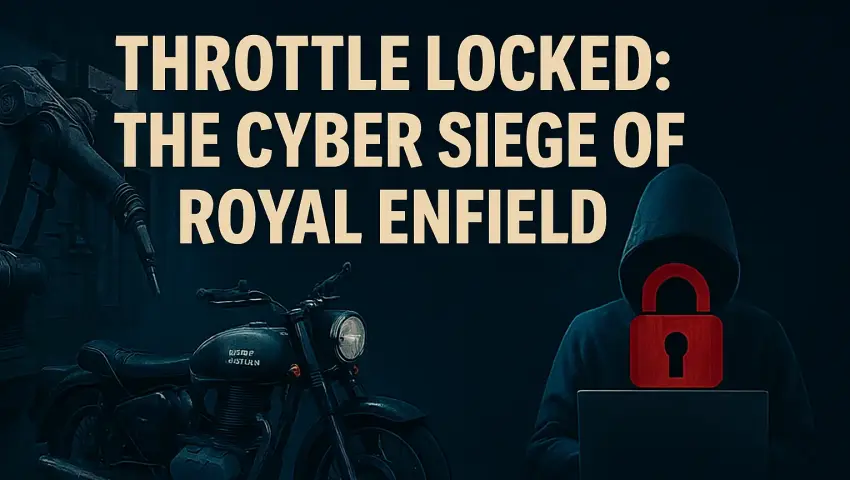
Throttle Locked: The Cyber Siege of Royal Enfield
The Breach Beneath the Chrome
In the early hours of August 13, 2025, a silent war erupted inside the digital infrastructure of one of the world’s oldest motorcycle manufacturers. Royal Enfield, the iconic brand whose machines have roared across continents since 1901, was allegedly struck by a devastating ransomware attack. The perpetrators? A shadowy cybercriminal group known as INC Ransom—a name increasingly feared across industrial sectors.

According to multiple reports, including Cybersecurity News and MAG212, the attackers claim to have executed a “full system compromise.” Every server encrypted. Every backup wiped. Screenshots posted on underground forums show internal file structures and encrypted directories, suggesting deep access to Royal Enfield’s core systems. The attackers reportedly demanded a ransom within 12 hours and invited private bids for the stolen data via encrypted messaging platforms like qTox.
This wasn’t a random hit. It was a calculated assault on a brand that has survived world wars, economic upheavals, and industrial revolutions. Royal Enfield, now headquartered in Chennai, India, and owned by Eicher Motors, is a global powerhouse in mid-weight motorcycles. Its legacy stretches from the British military’s airborne divisions to modern adventure riders scaling the Himalayas. You can trace its full history on Wikipedia or explore its roots in British Heritage.
The implications of this breach are severe. If the attackers’ claims are accurate, the intrusion could disrupt production, dealer operations, and customer support across Royal Enfield’s global network. Intellectual property—including proprietary design files and engineering data—may be exposed. Sensitive contracts, financial records, and customer databases could be in hostile hands.
Royal Enfield has not publicly confirmed the full extent of the breach. In a brief statement cited by GBHackers, the company acknowledged reports of a cybersecurity incident and confirmed that it has activated its incident response protocols, working with law enforcement and cybersecurity experts.
Meanwhile, INC Ransom waits in the shadows. Known for its double-extortion tactics—stealing data before encrypting systems—the group has previously targeted industrial, healthcare, and education sectors across the US and Europe. Their methods include exploiting public-facing applications, harvesting credentials, and deploying custom ransomware payloads that disable defenses and lock entire networks.
This is not just a cyberattack. It’s a direct challenge to a legacy built over 124 years. And the clock is ticking.
Timeline of the Royal Enfield Ransomware Attack
This timeline reconstructs the events surrounding the alleged ransomware attack on Royal Enfield, based on publicly available sources and cybersecurity analysis. Where exact timestamps are unavailable, estimates are clearly indicated.

August 11–12, 2025 (Estimated Reconnaissance Phase)
Security researchers believe the attackers may have gained initial access during this window, likely through compromised credentials or a vulnerable remote-access service—methods consistent with INC Ransom’s known tactics.
Estimated activities: Credential harvesting, privilege escalation, lateral movement, and staging of ransomware payloads.
Tools likely used: PSexec, AnyDesk, TightVNC, and MegaSync for data exfiltration.
August 12, 2025 – Late Evening
A post appears on a dark-web leak site claiming a “full system compromise” of Royal Enfield’s network.
Attackers claim all servers were encrypted and backups deleted.
A 12-hour ransom deadline is issued, with private bids invited via encrypted messaging platforms like qTox and Telegram.
Source: Cybersecurity News.
August 13, 2025 – Morning
Multiple cybersecurity outlets begin reporting on the breach.
MAG212 publishes screenshots allegedly taken from Royal Enfield’s internal systems.
Royal Enfield has not yet issued a public statement but is reportedly investigating the claims.
Analysts warn of potential disruption to manufacturing, dealer networks, and customer support.
August 13, 2025 – Afternoon
Security researchers confirm the attack follows the double-extortion model:
Data is exfiltrated before systems are encrypted.
Attackers threaten to leak sensitive files if the ransom is not paid.
INC Ransom’s tactics align with MITRE ATT&CK techniques such as T1078 (Valid Accounts) and T1486 (Data Encrypted for Impact).
August 14–15, 2025 (Estimated Response Phase)
Royal Enfield likely initiates containment and forensic analysis.
Estimated actions: Network segmentation, log preservation, credential resets, and backup restoration.
Regulatory obligations: Under India’s CERT-In guidelines, major breaches must be reported within six hours—Royal Enfield is expected to comply.
August 16, 2025 and Beyond
As of this writing, Royal Enfield has not publicly confirmed the full scope of the breach.
Cybersecurity experts advise monitoring for phishing campaigns and impersonation attempts targeting suppliers and customers.
Long-term consequences may include reputational damage, regulatory scrutiny, and operational delays.

Estimated Financial Losses from the Royal Enfield Ransomware Attack
While Royal Enfield has not disclosed the financial impact of the alleged ransomware breach, we can estimate potential losses by examining similar incidents in the manufacturing and automotive sectors. These estimates include direct costs (ransom, recovery, legal fees) and indirect costs (downtime, reputational damage, regulatory penalties).
1. Ransom Payment (Estimated)
The attackers reportedly demanded payment within 12 hours and invited private bids via encrypted platforms like qTox and Telegram.
Estimated ransom demand: $1.5–$3 million
This range is based on similar attacks in the automotive sector, where ransom demands often fall between $1 million and $5 million.
2. Operational Downtime
Royal Enfield’s production, dealer systems, and customer support may have been disrupted.
Estimated downtime cost: $500,000–$1.2 million per day
If operations were impacted for 3–5 days, total downtime losses could reach $1.5–$6 million.
3. Data Recovery and IT Remediation
Restoring systems, validating backups, and conducting forensic analysis are costly.
Estimated recovery cost: $2–4 million
This includes hiring cybersecurity experts, replacing compromised infrastructure, and implementing new security protocols.
4. Legal, Regulatory, and Compliance Costs
India’s CERT-In mandates breach reporting within six hours. If customer or supplier data was exposed, Royal Enfield could face legal scrutiny under Indian and international data protection laws.
Estimated legal and compliance costs: $1–2 million
This includes legal counsel, regulatory filings, and potential fines.
5. Reputational Damage and Brand Impact
Loss of customer trust, dealer confidence, and media scrutiny can affect sales and market position.
Estimated reputational impact: $2–5 million
This includes lost revenue, increased marketing spend, and potential customer churn.
Total Estimated Financial Impact
Combining all categories, the estimated total financial loss from the ransomware attack could range between:
$8 million and $20 million
This estimate aligns with industry averages for ransomware attacks on large manufacturers, which typically range from $4.5 million to over $20 million depending on breach severity.

How Cy-Napea® Could Have Defended Royal Enfield
Had Royal Enfield been protected by Cy-Napea®, the ransomware attack might have been prevented or significantly mitigated. Cy-Napea® is built around a four-layer defense strategy designed to counter modern cyber threats at every stage—from human error to advanced persistent attacks. Here's how each layer could have helped against the tactics reportedly used by the Black Basta group.
Layer 1: Security Awareness Training
Every cybersecurity strategy begins with people.
Cy-Napea® delivers simulation-based training that equips employees to recognize phishing emails, impersonation attempts, and suspicious behavior. These are the same tactics commonly used by ransomware groups to gain initial access. By reinforcing vigilance through ongoing, adaptive training, Cy-Napea® helps build a resilient human firewall.
Potential Impact: Employees may have identified and reported the phishing attempt, preventing the breach at its earliest stage.
Layer 2: Advanced Email Security
Cy-Napea® scans inbound communications in real time using behavioral analytics, sandbox detonation, and spoofing prevention. Attachments and links are tested in isolated environments, and impersonated domains or senders are automatically flagged and blocked.
Potential Impact: Malicious emails and payloads could have been intercepted before reaching employee inboxes.
Layer 3: EDR/XDR Threat Detection and Response
Cy-Napea® continuously monitors endpoints, servers, and cloud environments for behavioral anomalies. If lateral movement, privilege escalation, or data exfiltration is detected, the platform responds automatically with endpoint isolation, credential lockdown, and forensic logging. It integrates seamlessly with SIEM platforms for centralized threat visibility.
Potential Impact: The attack could have been detected and contained before ransomware was deployed.
Layer 4: Continuous Backup with Immutable Storage
Even if ransomware bypasses all other defenses, Cy-Napea® ensures that critical data is continuously backed up, encrypted, and stored in immutable formats. These backups cannot be altered or deleted—even by compromised admin accounts—and can be restored instantly to minimize downtime and data loss.
Potential Impact: Royal Enfield could have restored operations quickly without paying ransom or losing sensitive data.
Legal Disclaimer
This analysis is produced by Cy-Napea® as part of an educational and strategic review of ransomware threats in the context of publicly reported events. All predictions and scenario-based commentary are based on publicly available data and known threat intelligence at the time of publication. No inference of fault, liability, or endorsement is made regarding Palm Bay International or any external entities mentioned. This article does not constitute legal advice or contractual guidance.




